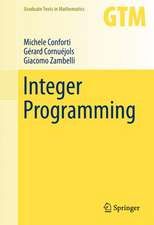Interactive Multiple Goal Programming: Applications to Financial Planning: International Series in Management Science Operations Research
Autor J. Spronken Limba Engleză Hardback – 30 apr 1981
| Toate formatele și edițiile | Preț | Express |
|---|---|---|
| Paperback (1) | 943.57 lei 6-8 săpt. | |
| SPRINGER NETHERLANDS – 14 oct 2011 | 943.57 lei 6-8 săpt. | |
| Hardback (1) | 949.55 lei 6-8 săpt. | |
| SPRINGER NETHERLANDS – 30 apr 1981 | 949.55 lei 6-8 săpt. |
Preț: 949.55 lei
Preț vechi: 1157.98 lei
-18% Nou
Puncte Express: 1424
Preț estimativ în valută:
181.70€ • 189.33$ • 150.44£
181.70€ • 189.33$ • 150.44£
Carte tipărită la comandă
Livrare economică 03-17 aprilie
Preluare comenzi: 021 569.72.76
Specificații
ISBN-13: 9780898380644
ISBN-10: 0898380642
Pagini: 276
Ilustrații: XII, 259 p.
Dimensiuni: 156 x 234 x 20 mm
Greutate: 0.56 kg
Ediția:1981
Editura: SPRINGER NETHERLANDS
Colecția Springer
Seria International Series in Management Science Operations Research
Locul publicării:Dordrecht, Netherlands
ISBN-10: 0898380642
Pagini: 276
Ilustrații: XII, 259 p.
Dimensiuni: 156 x 234 x 20 mm
Greutate: 0.56 kg
Ediția:1981
Editura: SPRINGER NETHERLANDS
Colecția Springer
Seria International Series in Management Science Operations Research
Locul publicării:Dordrecht, Netherlands
Public țintă
ResearchCuprins
1. Introduction.- 1.1. Motivation.- 1.2. Scope of the Study.- 1.3. Outline of the Contents.- References.- 2. Multiple Goals in Capital Budgeting and Financial Planning.- 2.1. Introduction.- 2.2. Constraints in Capital Budgeting and Financial Planning.- 2.3. The Goal of Market Value Maximization.- 2.4. Assumptions with Respect to the Decision Maker and the Organization.- 2.5. The Firm’s Market Value as One of the Elements in a Dynamic Goal Complex.- References.- 3. A Survey of Multiple Criteria Decision Methods.- 3.1. Terminology and Basic Concepts.- 3.2. Decision Problems and Methods.- 3.3. Some Characteristics of Decision Problems.- 3.4. A General Overview of Available Methods.- 3.5. An Overview of Multiple Objective Programming Methods.- 3.6. Conclusion.- References.- 4. Goal Programming.- 4.1. General Formulation.- 4.2. The Objective Function.- 4.3. Solution Procedures.- 4.4. An Adapted Simplex Procedure.- 4.5. Concluding Remarks.- References.- 5. Interactive Multiple Objective Programming Methods.- 5.1. Features of an Interactive Approach.- 5.2. Elements of Interactive Methods.- 5.3. The Need of an Interactive Variant of Goal Programming.- 5.4. Interactive Goal Programming Methods.- 5.5. Conclusion.- References.- 6. Interactive Multiple Goal Programming.- 6.1. Definitions and Assumptions.- 6.2. Description of the Procedure.- 6.3. IMGP in Linear Terms.- 6.4. Existence, Feasibility, Uniqueness and Convergency.- 6.5. Concluding Remarks.- Appendix 6.a. Suitable Starting Solutions.- References.- 7. IMGP in Practice: Examples and Experiences.- 7.1. Two Simple Examples.- 7.2. Experiments with an Imaginary Decision Maker.- 7.3. Some Empirical Results.- 7.4. IMGP Applied to Discrete Decision Problems.- 7.5. Conclusions.- Appendix 7.a. Computer Program Used for theExperiments with an Imaginary Decision Maker.- Appendix 7.b. An Operational Computer Program for IMGP.- References.- 8. Capital Budgeting and Financial Planning with Multiple Goals.- 8.1. A Brief Survey of the Literature.- 8.2. Large Numbers of Goal Variables.- 8.3. Goal Variables Requiring Special Treatment.- 8.4. Indivisibility of Projects.- 8.5. Conclusion.- References.- 9. Using IMGP for a Financial Planning Model: An Illustration.- 9.1. Introductory Remarks.- 9.2. Description of the Model.- 9.3. Selection of a Financial Plan (Continuous Case).- 9.4. Selection of a Financial Plan (Discrete Case).- 9.5. Conclusion.- References.- 10. Evaluation.- 10.1. Implementation of IMGP.- 10.2. Main Advantages of IMGP.- 10.3. Some Disadvantages and Areas for Further Research.- 10.4. Concluding Remarks.- References.- Author Index.


















